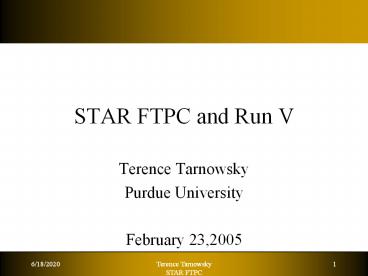Terence Tarnowsky - PowerPoint PPT Presentation
Title:
Terence Tarnowsky
Description:
Terence Tarnowsky. STAR FTPC. 4. Run Parameters ... Terence Tarnowsky. STAR FTPC. 9. Gain Scan. Data runs w/ anode voltages ranging from 1725-1825 V. ... – PowerPoint PPT presentation
Number of Views:20
Avg rating:3.0/5.0
Title: Terence Tarnowsky
1
STAR FTPC and Run V
- Terence Tarnowsky
- Purdue University
- February 23,2005
2
Outline
- I. FTPC parameters in Run V
- II. Operational Status
- III. Calibration Status
- IV. Summary
3
FTPC Group
- Volker Eckardt (MPI)
- Alexei Lebedev (BNL)
- Markus Oldenburg (LBL)
- Jörn Putschke (MPI)
- Janet Seyboth (MPI)
- Peter Seyboth (MPI)
- Frank Simon (MPI)
- Brijesh Srivastava (Purdue)
- Terry Tarnowsky (Purdue)
Thanks to Michael DePhillips Lidia Didenko Eric
Hjort Jerome Lauret Jeff Porter For
invaluable technical support!
4
Run Parameters
- FTPCs operational for both Cu-Cu and upcoming pp
running. - Cu-Cu
- 200 GeV, 62.4 GeV, injection energy.
- pp
- 200 GeV polarized, 500 GeV (?).
- Based on cluster properties, anodes at 1775 V for
200 GeV Cu-Cu - Early data taken at 1800 V. Change is mostly
transparent to end users. - Appropriate settings for other energies/species
TBD from initial data.
5
Electronics
- Alexei Lebedev installed protection boards for
all FTPC FEEs during summer shutdown. - Purpose was to mitigate destructive energy
discharge to pad plane during anode trip. - All FEEs retrofitted.
6
Electronics II
Status _at_ end of Run IV
Status _at_ start of Run V
7
Electronics III
- Beam backgrounds very high in this Cu-Cu run ?
fairly frequent anode trips. - Fewer large scale losses compared to this time in
Run IV. - Electronics more stable and reliable .
Run V, Day 041 Run IV, Day 053
8
Extra Temperature Sensors
- During summer shutdown additional FTPC body
temperature sensors installed. - Improves detector reliability. Accurate
temperature readings are essential to
reconstruction. - New sensors operate on a completely autonomous
system (no readout through FTPC RDOs). - Even if original temperature readings are
non-functioning, new sensors provide temperature
readout.
9
Gain Scan
- Data runs w/ anode voltages ranging from
1725-1825 V. - Compare cluster and charge distributions.
- Compare cluster r, f residuals.
- View raw clusters as function of pad vs. time
using FTPC Pad Monitor.
10
Gain Scan II
AuAu 5033089, 1775 V CuCu 6012007, 1775 V
AuAu 5033089, 1775 V CuCu 6012007, 1775 V
11
Laser Calibration
- FTPC uses lasers to check drift velocity, t0, and
corrections. - This requires (bare
- minimum)
- Inner and outer straight
- tracks.
- One inclined track.
12
Laser Calibration II
Laser run 6048026, 1400 V
Laser run 6034019, 1200 V
Along with gain, alignment can be adjusted.
13
Laser Calibration III
- Unlike the TPC, FTPC does not continuous laser
runs for calibration. - Only need one (minimum) good run for
calibration purposes. - More is always better (of course!)
- Work in progress. Odds of success relatively high.
14
Transverse Vertex Offset
- Align FTPC x,y vertex position w/ TPC vertex.
- Requires completed TPC calibration and fixed
vertex. - In Run IV data, a B-field dependent effect led to
the calculation of offsets after every field
change
15
Vertex Offset II
- Initial Run IV offset calculated from RFF data
only.
Produced RFF data OK
Produced FF data shows uncorrelated shift in x or
y.
16
Vertex Offset III
- After correcting for each specific B-field
configuration, x,y vertex position is OK. - For Run V, will repeat this procedure.
- Cause of field dependent effect still
unidentified, but additional corrections more
thorough anyway.
17
Future Improvements
- Will receive two, 40x70mm SSD modules to install
at a fixed position between FTPC body and
electronics. - This absolute position reference will allow
independent verification of drift velocity and t0
measurements. - SSD group has graciously provided modules and use
of their readout electronics. - Installation planned for Summer 2005.
18
Summary
- FTPCs are operating well, no major problems to
report. - Some difficulty achieving good laser tracks, but
work on alignment will continue. - Improvements to FEEs and temperature measurement
provide valuable extra reliability ? more useable
data! - Future improvements (such as fixed position SSD
modules) will add another level of reliability to
calibration process.































